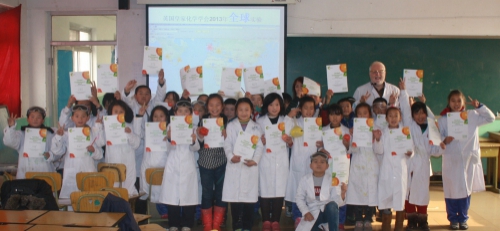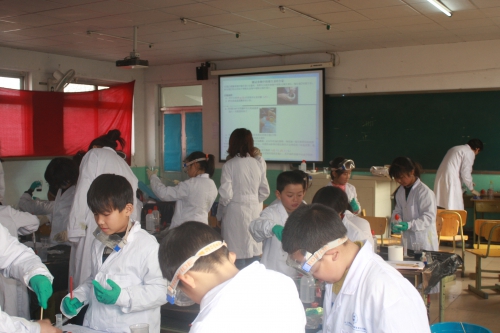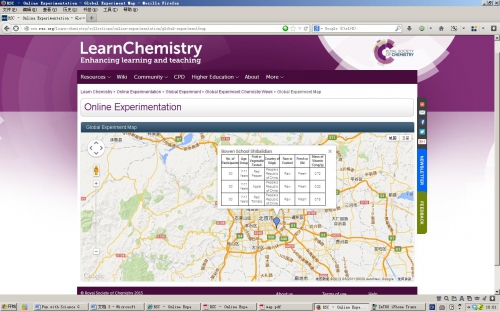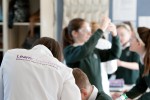As I begin planning for the new Royal Society of Chemistry, Global Experiment 2014
(watch out for it later this summer) I found myself looking back fondly over the successful experiment last year which was run 21K times all around the world. Thanks to all who participated and shared all your photos and reports.
As a result, I do want to share one last story of the experiment from Bowen School Shibalidian of students taking part.
Also as a reminder the
Experiment is still open for posting for those still wanting to take part.

Science events ’Fun with Science’ organized by the Royal Society of Chemistry Beijing Local Section with the help of volunteers from Beijing University of Chemical Technology were on the topic of food and health. We discussed why fruit and vegetables (being packed with vitamins—especially vitamin C—and fibre) are healthier than high fat/high sugar foods like biscuits and cakes—although the students did admit they enjoyed eating the latter as well! But how do we know how much vitamin C is present in different fruits and vegetables? Take tomatoes, sweet red peppers and apples: can you guess which contains the most vitamin C? In “Fun with Science” we didn’t have to guess—we used chemistry to find out!

Armed with tincture of iodine(an antiseptic which can be bought at the local pharmacy), 30 Year 4 Bowen students set out to measure the amounts of vitamin C in weighed amounts of the tomatoes, sweet red peppers and apples. When the dark brown tincture of iodine solution is added drop by drop to a solution containing vitamin C it undergoes a chemical reaction which turns it colourless. However if the solution also contains cornstarch, when the vitamin C has all been used up the next drop of iodine solution reacts with the starch to make a dark blue–black colour.
The students had great fun mashing up their samples of fruit and vegetables to release the vitamin C and after dissolving it in water and adding starch solution, carefully counting the number of drops of tincture of iodine they had to add to the rapidly stirred solution before it went blue–black. And what was the result? They found that the apple needed slightly more drops of iodine solution than the tomato before the solution went blue–black, but the sweet red pepper needed many more drops, showing that the vitamin C content of the pepper is much higher than that of apples or tomatoes.
But although the students now knew red pepper contained the most vitamin C, they still didn’t know exactly how much—how many milligrams (mg) of vitamin C are contained in one gram (g) of fruit or vegetable. To do this they needed to react their iodine solution with what we call a “standard solution”—one containing a known amount of vitamin C. Fortunately vitamin C tablets contain exactly 1000 mg of vitamin C, so by dissolving one tablet in 1000 milliliters (mL) of water they were able to make a standard solution containing 1 mg of vitamin C in every mL of solution.
Using this solution they could then find out find out how many mg of vitamin C correspond to each drop of iodine solution and finally calculate the amounts of vitamin C in their samples. The average results for the class were:
Tomato 0.19 mg/g
Apple 0.22 mg/g
Sweet red pepper 0.72 mg/g

This was a special “Fun with Science” session because it was part of the Royal Society of Chemistry’s Global Experiment for 2013. Children from hundreds of schools all around the world have carried out the same experiment and uploaded their results onto the Royal Society of Chemistry
website. So now Bowen School Shibalidian is really on the map!
Every pupil who takes part in the Global Experiment and submits their data receives a certificate from the Royal
Society of Chemistry, and the Bowen students were delighted to receive theirs at the end of the experiment—just like their fellow students all over the world.
The Royal Society of Chemistry’s General Manager for China Dr. Amy Lam and Chair of the Beijing Local Section Prof. David Evans and the team of volunteers (below) presented certificates.

